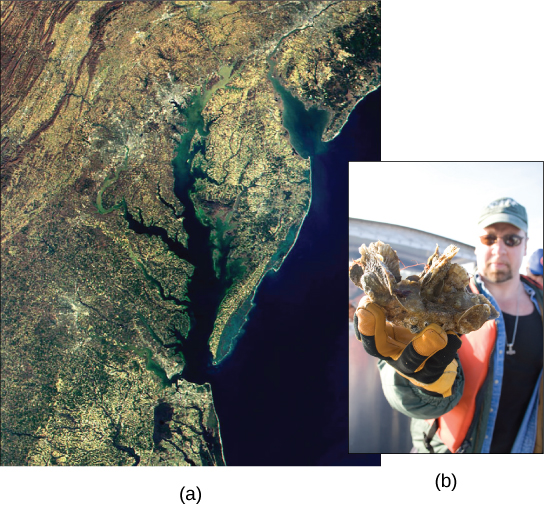| << Chapter < Page | Chapter >> Page > |

The Chesapeake Bay ( [link] a ) is one of the most scenic areas on Earth; it is now in distress and is recognized as a case study of a declining ecosystem. In the 1970s, the Chesapeake Bay was one of the first aquatic ecosystems to have identified dead zones, which continue to kill many fish and bottom-dwelling species such as clams, oysters, and worms. Several species have declined in the Chesapeake Bay because surface water runoff contains excess nutrients from artificial fertilizer use on land. The source of the fertilizers (with high nitrogen and phosphate content) is not limited to agricultural practices. There are many nearby urban areas and more than 150 rivers and streams empty into the bay that are carrying fertilizer runoff from lawns and gardens. Thus, the decline of the Chesapeake Bay is a complex issue and requires the cooperation of industry, agriculture, and individual homeowners.
Of particular interest to conservationists is the oyster population ( [link] b ); it is estimated that more than 200,000 acres of oyster reefs existed in the bay in the 1700s, but that number has now declined to only 36,000 acres. Oyster harvesting was once a major industry for Chesapeake Bay, but it declined 88 percent between 1982 and 2007. This decline was caused not only by fertilizer runoff and dead zones, but also because of overharvesting. Oysters require a certain minimum population density because they must be in close proximity to reproduce. Human activity has altered the oyster population and locations, thus greatly disrupting the ecosystem.
The restoration of the oyster population in the Chesapeake Bay has been ongoing for several years with mixed success. Not only do many people find oysters good to eat, but the oysters also clean up the bay. They are filter feeders, and as they eat, they clean the water around them. Filter feeders eat by pumping a continuous stream of water over finely divided appendages (gills in the case of oysters) and capturing prokaryotes, plankton, and fine organic particles in their mucus. In the 1700s, it was estimated that it took only a few days for the oyster population to filter the entire volume of the bay. Today, with the changed water conditions, it is estimated that the present population would take nearly a year to do the same job.
Restoration efforts have been ongoing for several years by non-profit organizations such as the Chesapeake Bay Foundation. The restoration goal is to find a way to increase population density so the oysters can reproduce more efficiently. Many disease-resistant varieties (developed at the Virginia Institute of Marine Science for the College of William and Mary) are now available and have been used in the construction of experimental oyster reefs. Efforts by Virginia and Delaware to clean and restore the bay have been hampered because much of the pollution entering the bay comes from other states, which emphasizes the need for interstate cooperation to gain successful restoration.
The new, hearty oyster strains have also spawned a new and economically viable industry—oyster aquaculture—which not only supplies oysters for food and profit, but also has the added benefit of cleaning the bay.

Notification Switch
Would you like to follow the 'Nsc 1406: contemporary biology' conversation and receive update notifications?